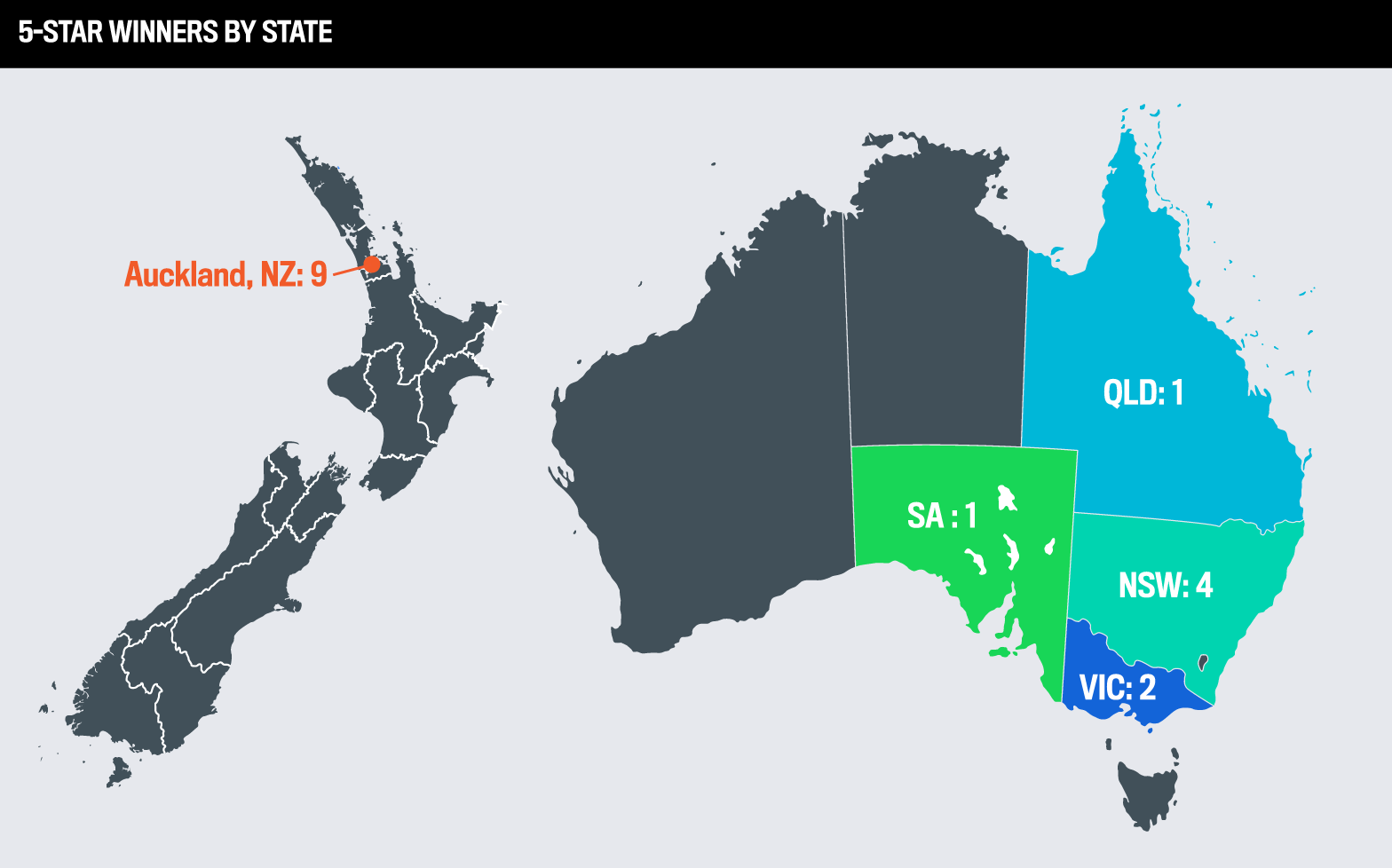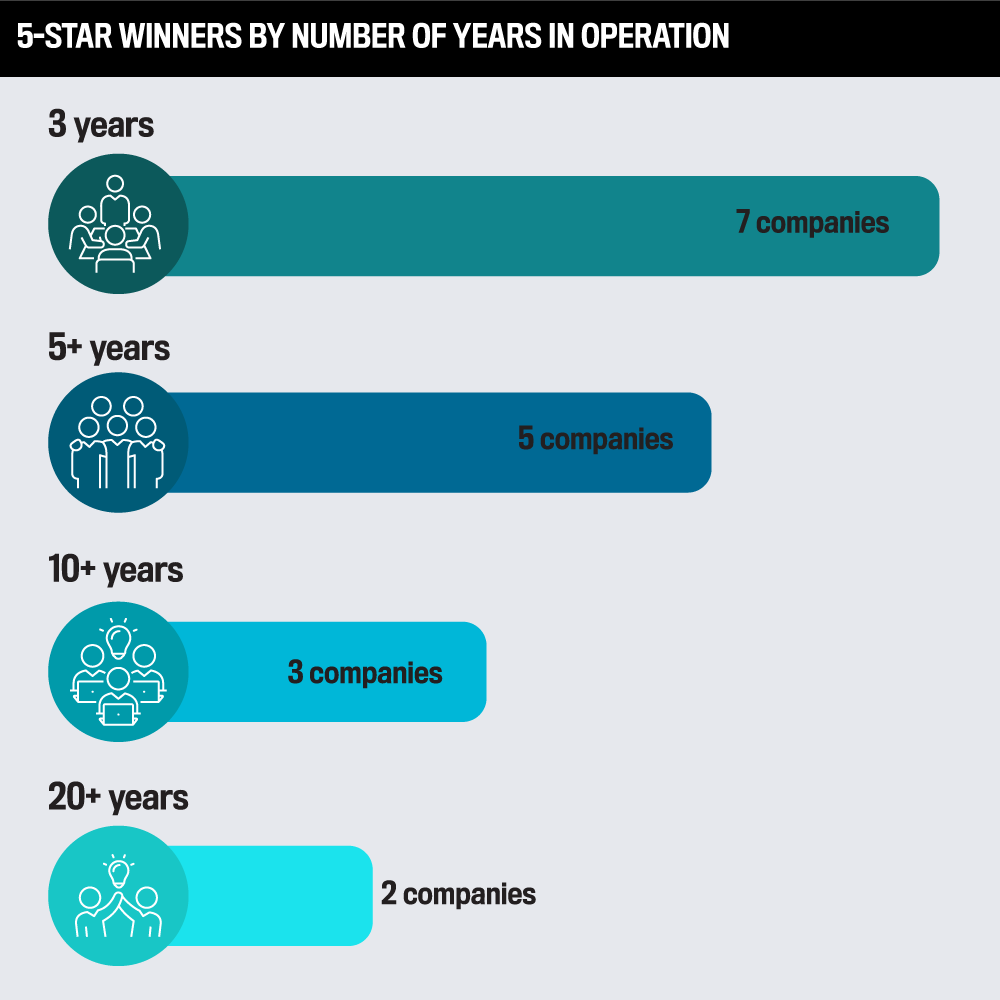
5-Star Insurance Technology Providers 2022
Jump to winners | Jump to methodology
Insurtech’s impressive evolution
Insurtech is thriving worldwide and attracting record sums of investment. In New Zealand, the insurtech market is seeing “a huge amount of interest, which is really exciting,” says Dale Smith, co-chair of InsurTechNZ and chief executive of JAVLN, a winner of IBNZ’s 5-Star Insurance Technology Providers award in 2022.
The reasons for insurtech’s success are numerous, but Smith attributes domestic growth to companies’ ability to address the business needs resulting from the widespread insurance market reforms in the country.
For this year’s insurance technology providers survey, IBNZ asked brokers to rate their overall satisfaction with leading insurtech providers in meeting these market demands. A total of 17 top-scoring companies are included in this year’s list. Whether addressing front- or back-office needs, transforming customer self-service capabilities or streamlining risk-rating tools and processes, the winners are on the cutting-edge of insurtech and worthy of recognition.
“I believe there has been more real progress in insurance technologies in the past two years than in the previous 20”
Rene Swindley, Initio
Initiating change with smart claims support
“I believe there has been more real progress in insurance technologies in the past two years than in the previous 20,” says Rene Swindley, CEO of Initio, another winner. “Up until recently, it has been a very slow-moving beast. We’ve been at the forefront of this evolution. There is a major shift in the way insurers interact with their customers, and the way data is used to solve insurability issues and settle claims – and this will only improve exponentially in the near future.”
Echoing Smith’s statement, Swindley says the “incredible inefficiencies” in insurance placement and policy management, for example, will drive the development of smart integrations and solutions.
One of those technologies is the Initio product, a smart claims platform for empowering customer self-service for home, contents, and car insurance. The product addresses the need to reduce the number of people involved in domestic insurance transactions and provides an extra level of customer control.
“At Initio, every technology feature, every site update, and every logic change is made with the customer in mind,” says Swindley. “It’s so important to never lose sight of how the end user interacts with your technology. We set out to create the easiest and most frictionless insurance experience in New Zealand; I am confident we have achieved that.”
Initio’s competitors include both mainstream insurers who have built or contracted out insurtech that enables customer self-service and software development shops to build their own solutions. “We are different in that we are full stack,” says Swindley. “We proudly own the customer journey and the technology that powers that journey, including our own in-house tech for instant customer-led coverage changes, claims management and education, and real-time smart underwriting (insurability).
“Initio is slick. Where others have failed, we’ve been able to provide integration, and API tools that enable partners like homes.co.nz to surface a house insurance quote instantly on every address lookup.”
For example, Initio can provide a partner or customer with a premium and the insurability profile of a property in less than six seconds. What’s more, the technology is scalable. Currently, Initio generates more than 40,000 automated domestic insurance quotes per day through partner integrations and direct customer interactions.
Where do they see themselves in three years? “We see ourselves continuing to lead digital change for the most frictionless customer insurance experience,” says Swindley.
“The insurance sector is fraught with aging and complex legacy systems and multiple data sources. As a result, it has been slower than many others to transform”
Alistair Harold, Grappler
Grappling with payment and policy reconciliation
Alistair Harold is excited about the boom in the domestic insurtech industry. The CEO and co-founder of Grappler, another award winner this year, says: “The insurance sector is fraught with aging and complex legacy systems and multiple data sources. As a result, it has been slower than many others to transform.”
Over the past few years, there has been a massive explosion of insurtechs in the marketplace. As insurers and underwriting agencies compete to attract and retain customers, many insurtechs have focused on the front office, creating different models to disrupt how consumers buy insurance. Grappler, however, has deliberately focused on the back office, driving operational efficiencies through automation and machine learning technology to transform the debtor management process, traditionally a very manual labour-intensive and costly back-office process.
Harold says that the company expects a shift from front-office to back-office transformation in the future. Insurers and underwriting agencies that have already undertaken front-office transformation are now looking to drive operational savings, and implement more efficient back-office process with improved insights and analytics on their debtor position.
Grappler is an end-to-end cloud-based solution focused on the payment to policy reconciliation process. It provides a streamlined, robust automated reconciliation process with debtor management insights, analytics and a simplified user experience.
“The benefit of our system is [providing] real insight into the payment cycle – from the broker right down to policy level – in one place, in real time, on a modern cloud technology stack,” says Harold.
Currently, competitor options include adding resources to undertake manual reconciliations through large offshore business process outsourcing teams, which don’t provide the operational savings or automation that is possible with Grappler.
“As for our accolades, we have had a 0% customer attrition rate since the company was founded in 2015,” says Harold. “Continuous positive feedback, ongoing recognition from external parties with industry awards and some of the tangible business benefits for our customers include reduced outstanding debt and unallocated cash, FTE savings, operational cost savings and efficiencies, reduced cost to serve and the ability to scale with accuracy.”
In three years, Grappler sees itself continuing to grow in the ANZ region and expanding internationally. It also sees itself undertaking continuous product development to deliver ongoing innovation and benefits to customers.
“The main application of our solution in New Zealand is via travel insurance, which has been decimated by COVID-19 and subsequent border closures and travel bans”
Talbot Henry, Verisk
Verifying the risk of pre-existing conditions
“The last two years have been a fascinating time for the insurance technology sector,” says Talbot Henry, head of sales, Australasia and strategic marketing Asia-Pacific for Verisk, another award winner. “The main application of our solution in New Zealand is via travel insurance, which has been decimated by COVID-19 and subsequent border closures and travel bans. We anticipated the industry to fully recover sometime in 2023, but it’s been encouraging to see New Zealanders’ willingness to travel again in [the second quarter], and the recovery has been amazing. This recovery highlights that the importance of travel insurance is at an all-time high.”
Verisk partners with insurers who use their automated underwriting tools to better understand the risk associated with pre-existing medical conditions. The company has risk-rating tools for various types of general insurance, including travel, health, income protection, and pet insurance. Henry says that Verisk draws on data from close to 30 million medical screenings per year (more than 50,000 per day).
“Combining this with the most up-to-date claims and mortality data ensures that the outputs are continually improved. Verisk partners with insurers who are empowered to make decisions on coverage that suit their personal appetite for risk. Verisk helps to automate the underwriting process to save time for insurers and seamlessly improve customer experience.”
Regarding their travel risk rating tool, the company has to deal with competitors such as Tamis and Antidote. One of the key differences is that both of these competitors are part of larger businesses that have other areas of focus.
“Over the next three years, we will be investing in product development and looking at new ways we can support our partners,” says Henry. “Examples of these products include international students, international private medical insurance, and critical illness. We also see great potential for our products in Asia and now have teams based in Shanghai and Singapore.”
Furthermore, all of Verisk’s recent partners are pleased with the speed and ease of their integrations, and the company will be launching a full widget integration soon.
5-Star Insurance Technology Providers 2022
- BAIS insurance technology (iBAIS 2.0)
- ClaimSafe (ClaimSafe)
- Cover Genius (XCLAIM)
- DigiSure (DigiSure)
- DUAL (WebRater)
- Folio.insure (Folio)
- Grappler (Grappler)
- Handdii (Handdii)
- Hello Claims (Hello Claims Application)
- Initio (Initio and Locatio)
- InsuredHQ (InsuredHQ)
- JAVLN (JAVLN Insurance)
- Merlynn (TOM)
- Procuret (Procuret)
- Sentro Group (Sentro)
- Verisk (EstImage)
Methodology
‘Market-leading’ is a term many technology companies use when describing their software. Now, 17 companies can claim that title on the back of hard market research from the people who matter most: insurance brokers.
To select the best insurance technology providers in 2022, IBNZ enlisted some of the industry’s top experts. During a 15-week process, the research team conducted one-on-one interviews with brokers and surveyed thousands more within IBNZ’s network to gain a keen understanding of what insurance professionals think about current market offerings.
Technology providers were asked to nominate their solution, explaining why it stands out against its competitors and what makes it the best in the market. IBNZ then reached out to brokers, asking them to rate their overall satisfaction with the insurance technology providers they dealt with. The top-scoring technology and software providers were named 5-Star Award winners.
70% of winners operate outside of Australia and New Zealand
8 years is the average period that the winners have been in business
7 winners provide client and policy management, document management/automation, and quote management services
Keep up with the latest news and events
Join our mailing list, it’s free!




